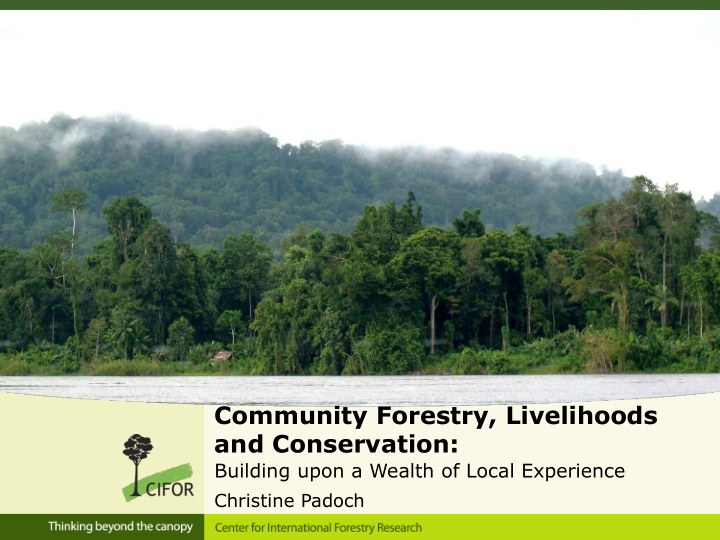



Community Forestry, Livelihoods and Conservation: Building upon a Wealth of Local Experience Christine Padoch
Promoting community forestry within sustainable landscapes while securing livelihoods and conserving ecosystem services is difficult However, there is much to build upon, both in the area of management practice and governance. Do community forestry practitioners take advantage of the resources that existing local patterns & practices offer?
Smallholders do not only “use” and “rely on” forests they also “manage” and “create” forests and forest resources For millennia forests and other non-agricultural • ecosystems have been managed to better satisfy a variety of human and societal needs, including the need for food However, many of these traditional forms of • management have remained “invisible” to many researchers and development practitioners and others have been criminalized We need to focus on identifying, understanding and • evaluating their realities, potentials, and the trade-offs they demand.
purma vieja chacra nueva Smallholders have long platano managed landscapes: an example from the chacra Amazon purma vieja chacra en produccion chacra en produccion frutal platano platano yucal y platanal frutal purma huerta
These systems often contribute significantly to food and income security A billion people depend to • some degree on forest resources Help ensure flexibility and • contribute to appropriate responses to the more frequent I climatic and economic perturbations that can be expected with climate change Can satisfy the burgeoning • needs for nutritional security of local communities .
Smallholder-managed Landscapes Shifting cultivation in Laos Managing forests for food production
Most forests are rich in “natural” resources but they are also rich because local groups have enriched forests through their knowledge and practice.
An example from Amazonia How are forests managed by local people?
Acai palm ( Euterpe oleracea ) broom raquiles dye fruit juice domestic animal fodder smoke rubber (coagulate) fruit fertilizer roof cover leaves � poguega � shri�p �ait wrap �pe�o�ha� �li��i�g �elt general covers leaves/ heart of palm crownshaft leaflets hat paper pulp construction beams foundation for general construction trunk trunk floor boards fences walls bridges � cacuri � fixed fishi�g trap Construction of raised plant bed Medicine for stomach roots Figure courtesy of E. Brondizio problems
Three Ways to Make an Acaizal Crops: Annuals bi-annuals Perennials Terrain preparation Unmanaged Selective clearing Unmanaged forest Clearing & leveling Papaya Acai Banana Lemon grass Pineapple Thinning & Sowing Inter-cropping Intensive Managed Acai plantation Transplanting in rows Pruning acai clumps Acai over bananas Acai monoculture Figure courtesy of E. Brondizio
Management for Multiple Products
Village of Tae Sanggau, Kalimantan Barat ADAT LAND SWIDDEN FALLOW TEMBAWANG
But these practices largely fall “between the cracks” They are not “managed enough” or • “formally enough” for development They are “too managed” for conservation • These systems are dynamic. • This is particularly unfortunate because • management also frequently creates rights to forests. •
Different forests, Different access rights Different communities Tembawang: Lineage group rights Tanah adat: Village rights Swidden-fallows: Household rights And they are all changing
Changing Communities (as well as Landscapes): Challenges to Community Forestry • Migration • Urbanization • Impact of remittances • How can these systems respond to these and other new challenges? • And how can we help?
Recommend
More recommend